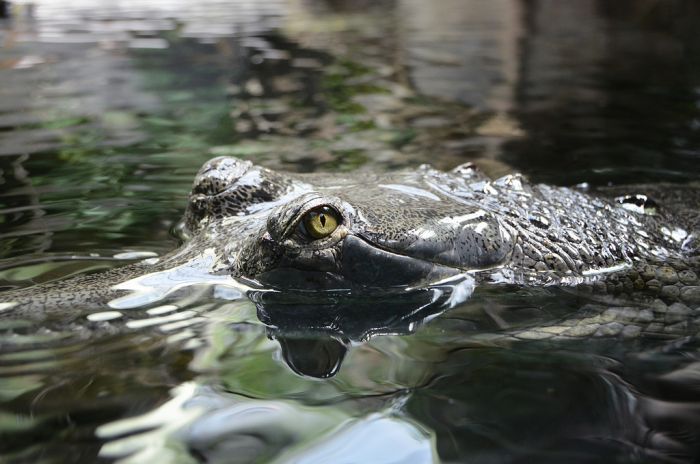|
|
Gharial Crocodile
|
Gharials' well-developed laterally flattened tail and webbed rear feet provide tremendous manoeuvrability in their deepwater habitat. On land, however, an adult gharial can only push itself forward and slide on its belly. Further enhancing its swimming abilities, the body of the gharial is relatively cylindrical in shape, compared with the broader, more powerfully built body of a saltwater or nile crocodile built for capturing various prey from the edges of waterways. The Gharial's elongated, narrow snout becomes proportionally shorter and thicker as an animal ages. The bulbous growth on the tip of a male’s snout renders gharials the only extant crocodilian with visible sexually dimorphic, other than size differences (in all crocodilians males are larger than females). This growth is present in mature individuals and called ghara after the Indian word meaning “pot”. Males utilize the structure to modify and amplify “hisses” snorted through the underlying nostrils. The resultant sound can be heard for nearly a kilometre on a still day. The ghara is thought to play an important role in gharial reproduction by identifying mature males to females and as an instrument in courtship auditory communication.
The Nepali word घड़ा ghaṛā means earthenware pot, pitcher, watervessel.
The leg musculature of the gharial does not enable it to raise its body off the ground to achieve the high-walk gait on land, but can only push its body forward across the ground ('belly-sliding'), although it can do this with some speed when required. However, when in water, the gharial is the most nimble and quick of all the crocodilians in the world. They can reach swimming speeds of at least 40 km/h (25 mph) while pursuing schools of fish. The jaws are lined with many interlocking, razor-sharp teeth — 27 to 29 upper and 25 or 26 lower teeth on each side. These teeth are not received into interdental pits; the first, second, and third mandibular teeth fit into notches in the upper jaw. The front teeth are the largest. The snout is narrow and long, with a dilation at the end and its nasal bones are comparatively short and are widely separated from the pre-maxillaries. The nasal opening of a gharial is smaller than the supra-temporal fossae. The lower anterior margin of orbit (jugal) is raised and its mandibular symphysis is extremely long, extending to the 23rd or 24th tooth. A dorsal shield is formed from four longitudinal series of juxtaposed, keeled, and bony scutes. The length of the snout is 3.5 (in adults) to 5.5 times (in young) the breadth of the snout's base. Nuchal and dorsal scutes form a single continuous shield composed of 21 or 22 transverse series. Gharials have an outer row of soft, smooth, or feebly keeled scutes in addition to the bony dorsal scutes. They also have two small post-occipital scutes. The outer toes are two-thirds webbed, while the middle toe is only one-third webbed. They have a strong crest on the outer edge of the forearm, leg, and foot. Typically, adult gharials have a dark olive colour tone while young ones are pale olive, with dark brown spots or cross-bands.
|
|









